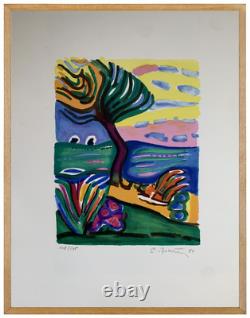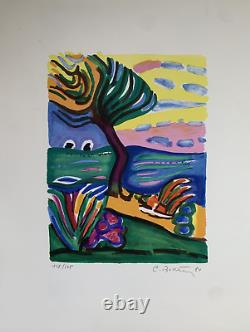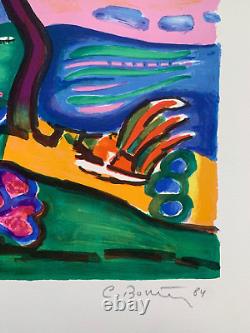
- Index
- Authenticity
- Characteristics
- Genre
- Abstract (88)
- Abstrait (363)
- Art Deco (52)
- Art Déco (109)
- Art Moderne (10)
- Art Naïf (30)
- Art Nouveau (97)
- Cubisme (26)
- Expressionism (50)
- Expressionnisme (162)
- Fauvisme (13)
- Modern (52)
- Moderne (18)
- Naive Art (20)
- Pop Art (40)
- Street Art (61)
- Streetart (87)
- Surrealism (22)
- Surréalisme (103)
- Symbolisme (14)
- Other (1397)
- Style
- Support
- Type
PISSARRO (1921-2021) Original Lithograph Fauvist Landscape Signed 1(7)








French school painter GRANDSON OF THE FAMOUS CAMILLE PISSARRO. ORIGINAL LITHOGRAPH ON PAPER SIGNED AND NUMBERED 148/175 FROM THE PISSARRO FAMILY ESTATE "100% AUTHENTIC GUARANTEE" (the buyer will be provided with a proper invoice mentioning the name of the expert who handled the artist's estate) DIMENSIONS OF THE ARTWORK 65 X 50 CM. THE FRAME IS NOT FOR SALE BUT IT ALLOWS YOU TO SEE THE ARTWORK IN SITUATION.
For homonymous articles, see Pissarro. National School of Decorative Arts.
Is a painter and graphic artist. Grandson of the painter Camille Pissarro.
He is the father of the French painter Frédéric Bonin-Pissarro. A Resistance fighter, he ensured the protection of French museum collections during World War II. And organized in the 1950s. A major art exhibition in Australia. Whose notable success brought many painters of the École de Paris to light.Jeanne Pissarro, (called Cocotte), reading, 1899, by Camille Pissarro. (called d'Artagnan, on the right) and Maxime Fischer.
(called Anatole on the left) in 1944. Claude Bonin-Pissarro is one of the sons of the French painter Alexandre Bonin. He married Sylvie Bonin-Pissarro (Sylvette Ormaechea).With whom he had a son, Frédéric. (born in 1964, painter), and a daughter, Lila. Claude's brother, Henri Bonin-Pissarro. Was assigned in 1943 by the Louvre museums. To ensure the protection and preservation of works of art.
Sheltered at the castle of Javon. Near Avignon in the Vaucluse. That same year, he joined the Resistance.As a liaison and intelligence officer under the command of Lieutenant Colonel Philippe Beyne. In principle, the Germans were not allowed to enter the castle of Javon. And with the help of Claude Bonin-Pissarro, Max Fischer.
Deposited weapons, ammunition, two trucks of clothing, shoes, and sweaters retrieved from the Cavaillon youth camps. : the men of the Ventoux Maquis. Came there to get dressed in small groups.
After the war, the works were returned to their respective museums. Claude Bonin-Pissarro at the National Gallery Adelaide with Felix Labisse's The Bee and Victor Brauner's Oppression of the Object.
Claude Bonin-Pissarro at the Tasmanian Museum and Art Gallery. The tapestry is entitled "There is always hope on earth. He entered the National School of Decorative Arts.
Where he studied art history. He then taught at the School of Arts and Crafts in Paris. In 1947, at the Villiers metro stop. In Paris, he spotted Simone Michels, a 25-year-old teacher, who thanks to him would embody Judith Toumignon in the film Clochemerle. As a representative of the French Action Art Association. Claude Bonin-Pissarro organized the rotating exhibition French Painting Today (Living Painters of the École de Paris). Featuring 119 paintings and four tapestries. By 77 French artists, which was proposed from January to September 1953. In the Australian cities of Hobart. This exhibition was a joint project of the French and Australian governments. Its organization took four years; the Australian organizer was the director of the National Art Gallery Sydney, Hal Missingham. The project was initiated by Jean Cassou. As head of the national museum of modern art. The French exhibition toured remarkably extensively.It began in January in Hobart at the Tasmanian Museum and Art Gallery. In March it opened in Sydney at the Art Gallery of New South Wales.
In April at the Queensland Art Gallery. In Brisbane; in June and July at the National Gallery of Victoria. In Melbourne; in August the National Museum of South Australia. In Adelaide; and concluded in Perth in September at the Public Library, Museum & Art Gallery of Western Australia. As Jean Cassou writes in his introduction to the catalog, the exhibition was marked by an approach to modernism from the perspective of art history and "universalism".
It presented established and renowned French modern artists like Braque. But also the younger generation, Reynold Arnould. In addition, the label "École de Paris." served as a generic term encompassing an equally wide geographical and national range, as it included German painters Max Ernst. , Portuguese Maria Helena Vieira da Silva.Who was born in Sydney in 1893 to French parents, but returned to France in 1900. Young Australian artists took a particular interest in the post-cubist high color of Manessier and Marchand and in tachisme. More identified with Vieira da Silva and Soulages. The paintings represented all trends in modern painting.
Although more innovative and contemporary than the Australian modern art exhibition of 1939: Herald Exhibition of French and British Contemporary Art, whose works were already considered classics. Among the works exhibited at French Painting Today, there were compositions such as The Passion by Georges Rouault. The Painter by Bernard Buffet. Memories by Lucien Coutaud, the Château de Saumur by Jules Lefranc, The Sleeping Port by Alfred Manessier. Three paintings by Le Corbusier.
(The woman with the book, The two sisters, Two hands and golden apple), two works by Henri Matisse. And many others by Jacques Villon. These pieces were loaned by the National Museum of Modern Art. From Paris or private collectors. Bonin-Pissarro had a hard time obtaining these loans, especially regarding the works of Picasso and Matisse.
Who was between 1945 and 1965 the curator of the National Museum of Modern Art. Invited the Australian public to savor this "spiritual adventure, our history of Modern Art.," the exhibition offering visitors a "key experience.
Claude Bonin-Pissarro faced various hassles even before the start of the exhibition in Australia. The 550-ton Merino cargo ship, through which the paintings were shipped to Australia, ran aground at Christmas 1952 in Bluestone Bay, off the coast of eastern Tasmania. And it was only after multiple dredging maneuvers that it was refloated.
Then the Australian customs confiscated the artworks and only agreed to return them after payment of storage fees, which they assessed at. The French government had insured these works for a value of. Which represents, as of 2014, approximately 2.25 million euros. Settled the dispute by paying the fees, but these formalities had already delayed the start of the exhibition for its first stop in Hobart. The exhibition, a true social phenomenon.In the Art Gallery of Western Australia alone. In Perth, the exhibition attracted 20,000 visitors. And the stop at the Queensland Art Gallery in Brisbane. With around 60,000 visitors, set a record for attendance.
The Melbourne exhibition attracted 80,000 visitors at the National Gallery of Victoria. And the Art Gallery of New South Wales.In Sydney had to limit the number of visitors to 100,000. Again breaking all previous records. A posteriori counts showed that for the cities of Melbourne and Sydney alone, the exhibition had attracted 200,000 visitors.
The sale of 12,000 copies of the catalog in Sydney was a record in itself. The exhibited works were at that time virtually unknown in Australia. The Australian public was generally resistant to the radical ideas of the European artistic scene, with the country's geographical isolation being no small factor in this orientation. The reception was mixed; it was not uncommon for Australian media to ridicule the paintings on display.
Several visitors felt "mystified" by this "provocative display" and attributed the "originality of the exhibited pieces to the traditional eccentricity of the French." According to various testimonies, Claude Bonin-Pissarro received hundreds of letters with passionate (positive or negative) assessments of the works on display.
The Australian writer Patrick White. "People forget that the average Australian has seen so little. Claude Bonin-Pissarro with Moya Dyring and the director of the National Art Gallery Sydney, Hal Missingham (1953).Bonin-Pissarro, who had only limited knowledge of English. And who was accompanied by an interpreter.
Considered himself as the "ambassador of French painting." He invited the public to consider the paintings without prejudice and with an open mind. He proposed the following comparison.
"Buildings, cars, planes are modern - well, naturalist painters. And he drew to support his comment an airplane and a car, and next to it a hitched car supposed to represent the old figurative painting. The Press described him as a. "vigorous defender of French Art. French Painting Today proved to be the most important international art exhibition held in Australia during the 1950s.With its "resolute optimism," it showed new paths to post-war Australia and gave considerable impetus to young Australian talents. At the Macquarie Galleries in Sydney, Claude Bonin-Pissarro organized an exhibition in February 1953 dedicated to the Australian cubist artist Moya Dyring.
In Adelaide in July, he expressed his admiration for the works of two other Australian artists, Wladyslaw and Ludwik Dutkiewicz, whom he considered the most beautiful of the country's Contemporary Art Society. He even praised the young Australian artist who had just been awarded the Blake Prize for Religious Art. He expressed the view that the collection exhibited at that time at the Art Gallery of South Australia.In Adelaide was the best manifestation of modern art in Australia. Upon his return from Australia, Claude Bonin-Pissarro worked as an engraver: in 1962, he created unexpected color combinations in the layout of the Annual Report of the Industrial Exploitation Service of Tobacco and Matches, which was well received. He accepted the position of artistic director. Of the OFREP agency, dedicated to the International Wool Syndicate and the Woolmark label.
He was one of the young graphic designers gathered by Jean-Paul Lhopital. At the French Book Club. Who participated in the renewal of layout and typography in publishing. At the end of his life, he lived in Galargues in Hérault. His workshop and that of his brother Henri Bonin-Pissarro were dispersed by the Montpellier auction house on.
As a painter, Claude Bonin-Pissarro is influenced by the fauvist and post-fauvist tradition. He mainly paints landscapes, forests, gardens, and coastlines: he is faithful to the thought of his grandfather Camille Pissarro who said. "You must have only one master, nature. "I have never left nature.
Born of it, I am a bit of nature. His pictorial compositions reflect the light and bright colors of southern France, where he resided. "My style varies with the feelings that the theme evokes in me." He made drawings of landscapes he had seen in Australia. He worked on a scenography. Whose first presentation was given in his presence on October 29, 1953 at the Sydney Town Hall. He exhibited, among others, at the Akka Valmay gallery on rue de Seine. And sometimes exhibits in his adopted country, Hérault.Descent of the sail: Stormy sky. Sunset in the green oaks. The pink path in the guillons, 1988. October 11 - November 6, 1984: Atelier Gallery, Nîmes. January 8 - February 2, 1985: Akka Valmay Gallery in Paris.
April 7 - May 2, 1987: hall of the savings bank, Peyrou. May 29 - June 28, 1987: Tourist Office of Auvers-sur-Oise. October 2001: Macquarie Gallery in Cincinnati. August 8 - August 30, 2009: Petit temple in Ganges. April 6 - May 7, 2016: Jean-Claude Réno Gallery, Montpellier. June 16 - September 30, 2017: Chapel of the Lawrence Durrell Space in Sommières.
